This sunny bank with its array of heathers not only supplements the biodiversity of the Middle Bourne Lane Community Garden but also recreates a fragment of the heathland dominated by heather and gorse that in Victorian times covered much of what is now South Farnham. At that time our landscape would then have looked like Frensham and Thursley Commons today.
The Plant
Common Heather or ling (Calluna vulgaris) grows widely across Europe on acidic soils in open, sunny situations. It is described as a low-growing perennial plant growing to 20 – 50 cms tall. Its mauve flowers appear in late summer – natural white varieties were traditionally considered lucky and were hawked by travellers. Now a great variety of cultivars have been developed with a great range of flower colours and flowering times. There are other heather species (Erica species) that grow best in wetland areas and bogs, and can be found in the wetter areas of Thursley
The Heather Bank
When we took over the maintenance of this garden in 2005 the bank was overgrown by aggressive, towering laurels, which were shading out most other plants. These were grubbed out and the bank was planted with heathers obtained from a local specialist nursery, according to this planting scheme.
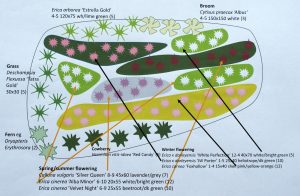
The range of heather varieties planted was devised to be a source of pollen and nectar throughout most of the year, so that even in winter, bees are other insects have forage.
The Value of Heather
The value of heather to wildlife is not restricted to nectar and honey. Grazing sheep and deer feed on the young shoots even when snow covers the ground. The caterpillars of several species of moths feed on it – notably the emperor moth, Saturnia pavonia. These caterpillars are preyed upon by some of Britain’s rarer solitary bees and wasps, which can sometimes be seen dragging their prey along the ground to their nesting holes.
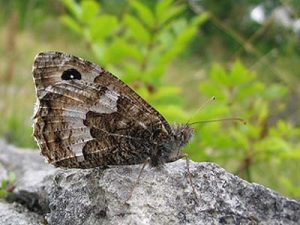
Heather was formerly used to dye wool yellow and also to tan leather. Leather making was an important industry in Farnham in the seventeenth century. It was also used for making besoms and for bedding.
Today heather honey is a highly valued product. Many bee-keepers move their hives to heathland areas in late summer. Heather honey has a characteristic taste and aroma. It also has a jelly-like consistency that makes it difficult to extract and is therefore often sold as honey-comb.
Heather’s place in Lowland Heathland
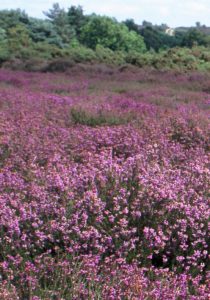
Lowland Heath is a habitat characterised by heather and gorse growing on poor and acidic soils at altitudes of less than below 300 metres (at high altitudes it is classed as moorland). Such heathland probably did not exist before the Bronze Age about 4000 years ago. These early farmers cleared trees either by cutting or burning them where they stood and started to grow cereals in patches. These quickly lost fertility and were abandoned and new sites cleared, thus creating a mosaic of habitats. Their animals were also allowed to roam free and their grazing played a major role in preventing the re-invasion of scrub. The farmers also used controlled burning to clear patches of the scrub and gorse which promoted fresh growth of heather that the stock thrived on. The disturbance caused by clearance and grazing generated a mosaic of habitats that favoured the development of a rich diversity of wildlife. These processes of tree removal, grazing and burning has led to the development of the heathland landscape we see today. However, as the intensity of this land-use has declined, dead vegetation accumulates, and the heathlands become vulnerable to large, damaging wildfires, some of which are sparked accidentally by broken glass, Chinese lanterns or barbecues, and some deliberately by vandals.
Today in Britain, there are an estimated 58,000 hectares of lowland heath. While this is an impressive 20% of the total world resource of lowland heath, it is a worryingly small remnant of what once existed: 80% has been lost since 1800 and 17% in the last 50 years. Today small areas, many of them isolated, are to be found in west Wales, Cornwall, Devon, Dorset, Hampshire, Surrey, Suffolk and Norfolk.
Wildlife
Many of Britain’s rarer breeding birds rely on lowland heath including the Dartford warbler, woodlark and nightjar. They are attracted by the large array of spiders and insects to be found in heathland, many of which are nationally rare. It also supports all six species of our native to reptiles – the adder, grass and smooth snakes, common and sand lizards, and slow worm.
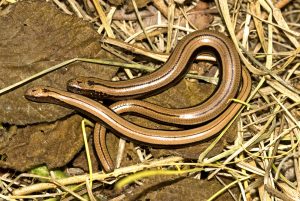
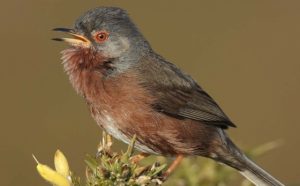
Locally, we are privileged by having Frensham and Thursley Commons nearby, but elsewhere lowland heaths are in decline being highly vulnerable to further fragmentation, lack of management and road and house building. This vulnerability in now recognised and greater efforts to conserve them and arrest their decline are being made by Natural England, the National Trust, the RSPB and others.
The RSPB Farnham Heath site
Since 2002, within a mile of this site, the RSPB has been restoring an area to heathland that had been planted with conifers to meet the wartime and post-war demands for timber. This has been controversial by many who wanted to keep it for woodland walks and were unconcerned about the loss of the original heathland species. The RSPB purchased the land and, after thorough wildlife surveys, cleared the trees. This took some time and the movements of heavy trucks carrying away the timber caused annoyance to some locally, rn. But remarkably heather soon began to re-establish, thanks to the seedbank surviving in the soil.
This operation has been highly successful. An area of heathland habitat has been regenerated that has already attracted back many of the bird and other species that had been lost. This re-establishment has largely being along the green corridors that link the site to Frensham Common, but also by active re-introduction if species. The site’s management is now primarily focussed on maintaining the habitat by preventing the re-invasion of scrub. This is done by grazing the land, thus mimicking the practices of older times. The mass of heather is a fine sight especially when in full bloom in July and August and it supports a wide variety of wildlife. This includes the ground-nesting nightjar, Dartford warbler, stonechat, tree pipit and woodlark as well as butterflies, moths, bats and badgers.The moths pictured below were all photographed locally by Martin Angel of The Bourne Conservation Group.
In the early days of the restoration work, The Bourne Conservation Group assisted with the clearance of the site and helped to build an otter holt on the River Wey.
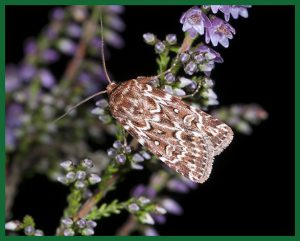
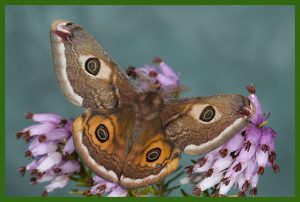
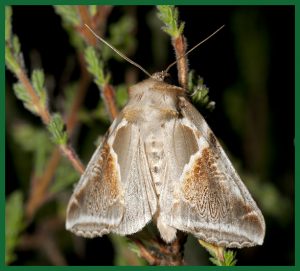
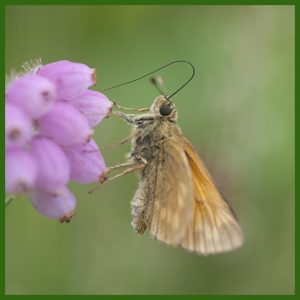
Working to improve the local environment
Creating this tiny representation of heathland as it used to be in this area has been part of the way of providing various habitats for wildlife in the Community Garden. Maintaining these habitats throughout the year is one of a number of ways in which The Bourne Conservation Group is enhancing local biodiversity as well as improving the landscape for local residents to enjoy.
There is always something that needs doing in a garden like this and it’s a lot of work. If you would like help please contact us on:
